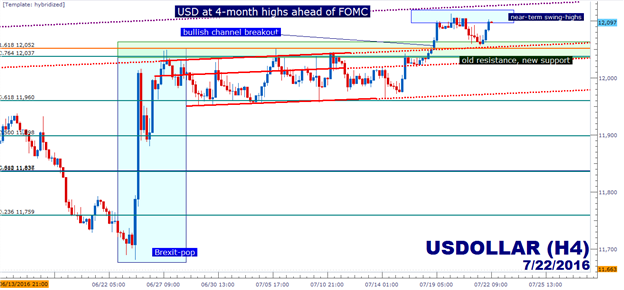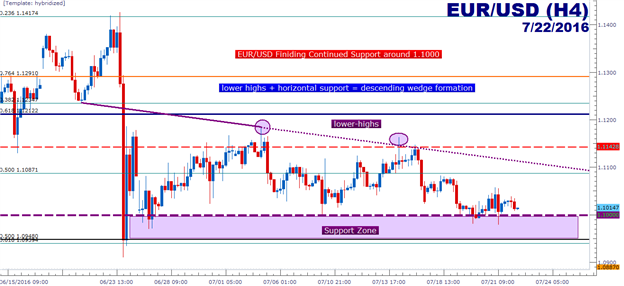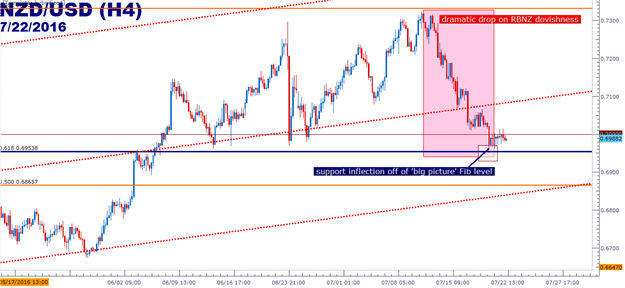To receive James Stanley’s analysis directly via email, please SIGN UP HERE
Talking Points:
- Next week brings another FOMC meeting; and while expectations for any actual moves at Wednesday’s rate decision are very low, the driver will likely be in the details of the Fed’s stance towards monetary policy moving forward.
- As the U.S. Dollar has surged to 4-month highs, many major pairings are sitting at or near key support levels. We look at two such examples below in EUR/USD and NZD/USD.
- If you’re looking for trading ideas, check out our Trading Guides. And if you want something more short-term in nature, check out our SSI indicator. If you’re looking for an even shorter-term indicator, check out our recently-unveiled GSI indicator.
Next week brings us yet another FOMC meeting, and after a rather active year in rate hike expectations markets are primed to move based around the bank’s stance next Wednesday. To be sure, no rate hikes are expected next week: Given the context of the global backdrop at the moment, that might be a bit too risky for a bank that’s had a tendency to be on the conservative-side towards rate hikes. But also considering the fact that U.S. Equities have ripped to even-higher all-time-highs, and also given the fact that the Fed has displayed a tendency to get ‘hawkish’ or talking up the prospect of rate hikes as stock prices have surged, and we may be in for another iteration of the world’s largest national Central Bank talking up the prospect of higher rates in the second half of the year. What we’re referring to is the ‘Fed Feedback Loop,’ which is the prospect of FOMC responding to stock prices rather than direct responses to their dual mandate of inflation and employment; getting dovish and talking up loose policy when stocks drop, and getting more hawkish and talking up rate hikes when stocks surge to new highs.
The point-of-interest for next week’s Fed meeting revolves around when and how many rate hikes the bank might be looking at in the coming quarters. To kick off the year, the Fed was expecting to hike rates a full four times in 2016. After global risk collapsed on the back of a slowing China and continued carnage in Commodity prices shortly after the open of the New Year, the bank backed down; lowering that expectation to two rate hikes for the remainder of the year at their March meeting. The simple act of reducing this expectation provided a dovish que to markets, which then bid U.S. equities to fresh near-term highs. And as global risks had continued to flare in the second quarter, highlighted by the brutal uncertainty surrounding the Brexit referendum, the expectation for even more dovishness out of Global Central Banks continued to propel stocks to fresh highs.
More recently, however, U.S. data has begun to show signs of strength , highlighted by the most recent NFP report that saw a blowout print far beyond expectations. The weakness in the labor market that had previously cemented the Fed’s case for a dovish stance towards rate hikes appears to be eroding.
So, as usual with FOMC announcements go into next week expecting volatility. There could be a chance to see continued USD-strength if the bank does, in fact, take a hawkish stance towards hikes in the remainder of the year, denoting recent strength in U.S. data.
As we go into next week’s Fed meeting, the US Dollar is at four-month highs. The Brexit referendum provided a considerable pop-higher in the Greenback, and since that move, price action has continued to hold higher-low support. Earlier this week saw another top-side breakout, with fresh support then showing at older resistance. As of this writing, we’re sitting near short-term swing highs; so traders may want to wait for a cleaner setup if looking to get long in the direction of the recent trend.

Created with Marketscope/Trading Station II; prepared by James Stanley
This recent surge in the US Dollar has brought many major pairings down to major support levels. These types of support levels can be used to either a) fade the move if looking for a reversal in USD, and this would likely need to be coupled with a dovish stance from the Fed next week; or b) looking for breakouts in the effort of trading a continuation of USD strength. On the chart below, we’re looking at one of the more interesting support zones in a major pairing with the 1.1000 psychological level on EUR/USD.

Created with Marketscope/Trading Station II; prepared by James Stanley
A pair that has seen significant volatility this week on the back of Central Bank expectations is NZD/USD. After the RBNZ had previously warned of a potential bubble in real estate with eyes on macro prudential reforms, markets had priced-out the prospect of rate cuts for the economy. But in an updated assessment released this week the RBNZ came straight-out and said that further easing will likely be taking place for New Zealand. This brought a bearish move in NZD across-the-board, with NZD/USD falling down to a strong zone of support. The level of .7000 is a ‘big’ psychological level, while the price of .6954 is 61.8% of the ‘big picture move’ in the pair (which is the same as a 38.2% retracement of that move), taking the low of .3900 from the year 2000 to the high set in 2011 at .8842.

Created with Marketscope/Trading Station II; prepared by James Stanley
--- Written by James Stanley, Analyst for DailyFX.com
To receive James Stanley’s analysis directly via email, please SIGN UP HERE
Contact and follow James on Twitter: @JStanleyFX







